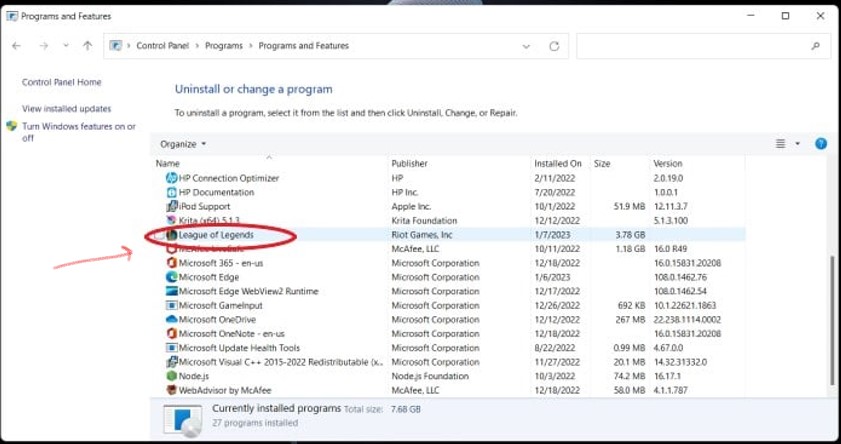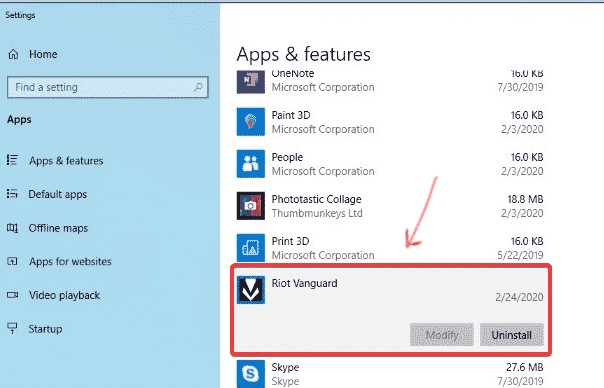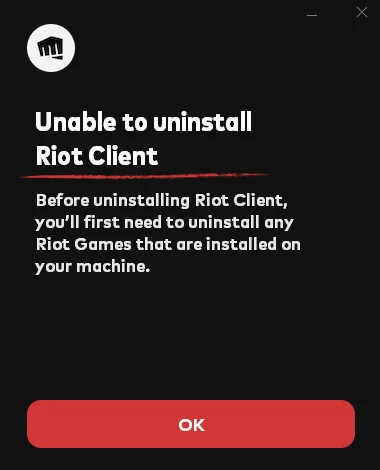Uninstalling software from your computer can sometimes be a complex process, especially when it comes to gaming clients like Riot Client. Whether you’re using a Windows PC or a Mac, there are specific steps you need to follow to ensure the client and all its associated files are completely removed. This guide will walk you through the process of how to uninstall riot client on both Windows and Mac operating systems, providing clear and easy-to-follow instructions. Before you begin, it’s important to remember to back up any important data to prevent accidental loss during the uninstallation process.
How do I uninstall Riot Client on PC?
The Riot Client is the hub for launching and managing games from Riot Games, such as League of Legends and Valorant. If you’re no longer playing these games or if you’re experiencing issues with the client, you might want to uninstall it. Here are the steps to uninstall the Riot Client on your PC:
- Close the Riot Client: Before uninstalling any program, it’s important to ensure that it is not currently running. Check your system tray to see if the Riot Client is running in the background, and if it is, close it.
- Open the Control Panel: Click on the Start menu and type “Control Panel” into the search bar, then click on the Control Panel app when it appears.
- Go to Programs and Features: In the Control Panel, click on “Uninstall a program” under the “Programs” category.
- Find the Riot Client in the list of programs: Scroll through the list until you find the Riot Client. It may also be listed as “Riot Games” or “League of Legends” depending on how you installed it.

- Uninstall the program: Click on the Riot Client in the list to select it, then click on the “Uninstall” button that appears at the top of the list. Follow the prompts to complete the uninstallation process.
- Delete leftover files: Sometimes, uninstalling a program doesn’t remove all of its files from your computer. To ensure that all Riot Client files are removed, go to your Program Files folder (usually located on your C: drive) and delete the “Riot Games” folder.
- Restart your computer: After uninstalling a program, it’s always a good idea to restart your computer to ensure that all changes are fully implemented.
Please note that these steps are for Windows operating systems. If you’re using a different operating system, the steps may vary slightly. Always remember to back up your data before uninstalling any programs to prevent accidental data loss. If you’re unsure about any of the steps, it’s best to consult with a professional or someone who is knowledgeable about computers.
How to uninstall riot client Mac?
Here are the steps to uninstall the Riot Client on your Mac:
- Quit the Riot Client: Before you can uninstall the Riot Client, make sure it isn’t running. If it is, quit the program.
- Open Finder: Click on the Finder icon in your dock to open a new Finder window.
- Go to the Applications folder: In the Finder sidebar, click on the “Applications” folder.
- Find the Riot Client: Scroll through your applications until you find the Riot Client. It might also be listed as “Riot Games” or “League of Legends” depending on how you installed it.

- Drag the Riot Client to the Trash: Click and drag the Riot Client icon to the Trash in your dock. Alternatively, you can right-click (or control-click) on the Riot Client and select “Move to Trash”.
- Empty the Trash: To completely uninstall the Riot Client, you’ll need to empty the Trash. Right-click (or control-click) on the Trash and select “Empty Trash”.
- Delete leftover files: Sometimes, uninstalling a program doesn’t remove all of its files. To ensure that all Riot Client files are removed, you’ll need to delete them manually. Open Finder and in the menu bar, click on “Go” and then “Go to Folder”. Type ~/Library/ and press enter. Look for any folders that contain “Riot Games” or “League of Legends” and move them to the Trash. Remember to empty the Trash afterwards.
Please note that these steps are for macOS. Always remember to back up your data before uninstalling any programs to prevent accidental data loss. If you’re unsure about any of the steps, it’s best to consult with a professional or someone who is knowledgeable about computers.
How to Uninstall Riot Client Using CMD
Here are the steps to uninstall the Riot Client using Command Prompt on a Windows PC:
- Open Command Prompt: Press Win + R to open the Run dialog box, type cmd, and press Enter to open Command Prompt.
- Find the Uninstall String: The uninstall string is a command that tells your computer how to uninstall a program. To find the uninstall string for the Riot Client, you’ll need to look in the Windows Registry. In Command Prompt, type the following command and press Enter:
reg query HKLM\SOFTWARE\Microsoft\Windows\CurrentVersion\Uninstall /s /f “Riot Client”
This command searches the Uninstall registry key for entries that contain “Riot Client”. Look for a line that starts with UninstallString. The text after REG_SZ is the uninstall string.
- Uninstall the Riot Client: To uninstall the Riot Client, you’ll need to run the uninstall string as a command in Command Prompt. Copy the uninstall string, paste it into Command Prompt, and press Enter.
Please note that these steps require administrative privileges. Always remember to back up your data before making changes to the Windows Registry to prevent accidental data loss. If you’re unsure about any of the steps, it’s best to consult with a professional or someone who is knowledgeable about computers.
How to Uninstall Riot Vanguard?
Below is how to uninstall Riot Vanguard from your computer, ensuring that all associated files are removed for a clean uninstallation. Remember, it’s always important to back up any important data before proceeding with the uninstallation process.
Here are the steps to uninstall Riot Vanguard:
- Close all Riot Games: Before uninstalling Riot Vanguard, make sure to close any running Riot Games like Valorant or League of Legends.
- Open the Control Panel: Click on the Start menu and type “Control Panel” into the search bar, then click on the Control Panel app when it appears.
- Go to Programs and Features: In the Control Panel, click on “Uninstall a program” under the “Programs” category.
- Find Riot Vanguard in the list of programs: Scroll through the list until you find Riot Vanguard.
- Uninstall the program: Click on Riot Vanguard in the list to select it, then click on the “Uninstall” button that appears at the top of the list. Follow the prompts to complete the uninstallation process.
- Restart your computer: After uninstalling Riot Vanguard, you’ll need to restart your computer to complete the process.

Please note that uninstalling Riot Vanguard may affect the functionality of certain Riot Games that rely on it for anti-cheat protection. Always remember to back up your data before uninstalling any programs to prevent accidental data loss. If you’re unsure about any of the steps, it’s best to consult with a professional or someone who is knowledgeable about computers.
Why can’t I Uninstall Riot?
There could be several reasons why you’re unable to uninstall Riot:
- Riot Games are still running: If any Riot Games like Valorant or League of Legends are still running, you may not be able to uninstall Riot. Make sure to close all Riot Games before attempting to uninstall.

- Insufficient permissions: You may not have the necessary permissions to uninstall programs on your computer. If you’re using a shared or work computer, you may need to ask the administrator for permission.
- Corrupted files: Sometimes, files related to the program can become corrupted, which can prevent the uninstallation process from completing. In this case, you may need to use a third-party uninstaller program to remove Riot.
- Riot Vanguard: Riot Vanguard, the anti-cheat software used by Riot Games, can sometimes cause issues with uninstallation. If you have Riot Vanguard installed, try uninstalling it first before uninstalling Riot.
Conclusion
Uninstalling the Riot Client, whether on Windows or Mac, involves a series of steps that require careful attention. On both operating systems, it’s crucial to ensure that all Riot games are closed before starting the uninstallation process. On Windows, the Control Panel is used to uninstall the program, while on Mac, the application is moved to the Trash from the Applications folder. It’s always recommended to restart your computer after uninstallation to ensure all changes are fully implemented. Lastly, remember to back up any important data before starting the process, and if you’re unsure about any steps, don’t hesitate to consult with a professional or someone knowledgeable about computers. Uninstalling software can sometimes be a complex task, but with careful attention and the right steps, it can be accomplished successfully.
FAQ
- Should I delete my Riot games before uninstalling Riot Client?
It’s not necessary to delete your Riot Games before uninstalling the Riot Client, but it can help ensure a clean uninstallation. Here’s why:
The Riot Client is a launcher for Riot Games like League of Legends and Valorant. When you uninstall the Riot Client, it should also uninstall the games associated with it. However, sometimes game files can be left behind, which can take up space on your computer.
By deleting your Riot Games first, you can make sure all game files are removed before you uninstall the Riot Client. Just remember to back up any game data you want to keep, like screenshots or saved games, before you delete anything.
After you’ve deleted your Riot Games, you can uninstall the Riot Client by following the usual uninstallation process for your operating system. Remember, it’s always a good idea to restart your computer after uninstalling programs
- How will I know that all traces of Riot Games have been removed from my PC?
To ensure that all traces of Riot Games have been removed from your PC, you can follow these steps:
- Check your installed programs: Go to your Control Panel and click on “Uninstall a program” under the “Programs” category. Look through the list of installed programs for any Riot Games or Riot Client entries. If you don’t see any, then they have been successfully uninstalled.
- Check your Program Files folder: Navigate to your Program Files folder (usually located on your C: drive) and look for a “Riot Games” folder. If it’s not there, then all Riot Games files have been removed.
- Check your AppData folder: Press Win + R to open the Run dialog box, type %appdata%, and press Enter. This will open your AppData folder, which can sometimes contain leftover files from uninstalled programs. Look for any “Riot Games” folders and delete them if they’re present.
- Use a third-party cleaner: If you want to be extra thorough, you can use a third-party cleaner like CCleaner to scan for and remove leftover files and registry entries. Please note that you should only do this if you’re comfortable with using these types of programs and always remember to back up your data first.

![How to Pause Location on Find My iPhone Without Them Knowing? [2024] 23 how to pause location on find my iphone](https://izood.net/wp-content/uploads/2024/10/How-to-Pause-Location-on-Find-My-iPhone-Without-Them-Knowing-400x300.png)


![How To Inspect Element on iPhone [4 Methods] 26 how to inspect element on iphone](https://izood.net/wp-content/uploads/2024/10/how-to-inspect-element-on-iphone-3-400x300.png)


